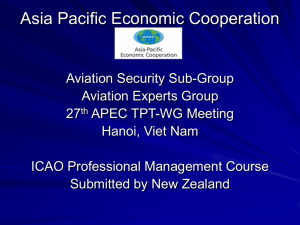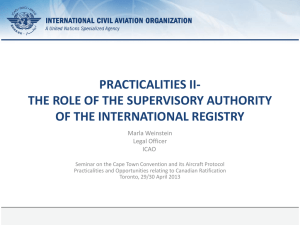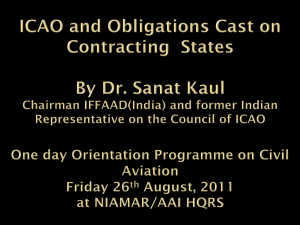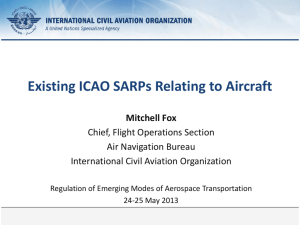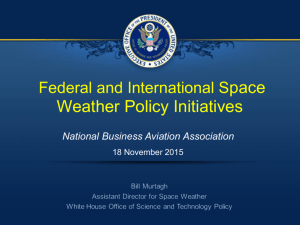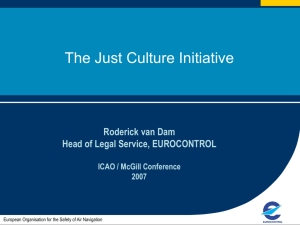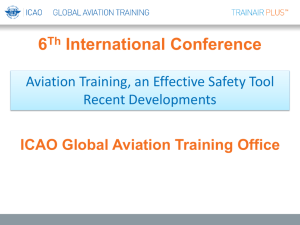The Chicago Convention as the Constitution of an
advertisement
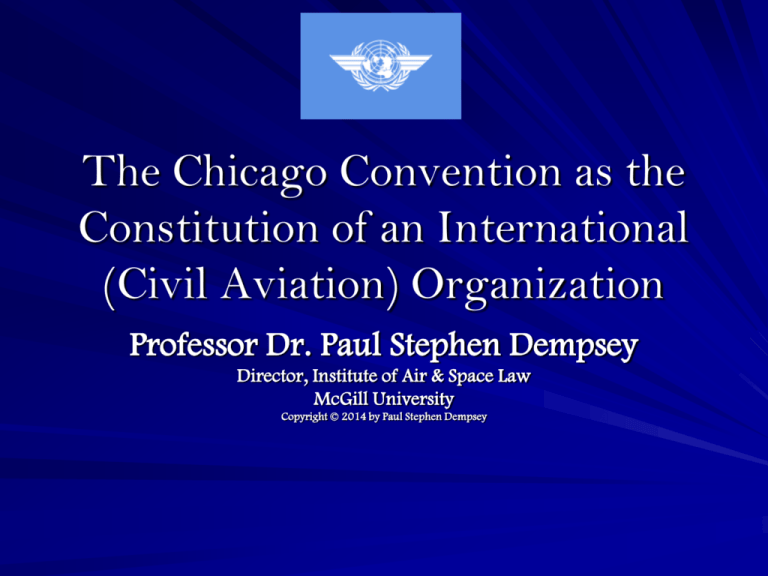
The Chicago Convention as the Constitution of an International (Civil Aviation) Organization Professor Dr. Paul Stephen Dempsey Director, Institute of Air & Space Law McGill University Copyright © 2014 by Paul Stephen Dempsey The Chicago Convention of 1944 has two principal functions: I. II. THE CHICAGO CONVENTION IS A SOURCE OF INTERNATIONAL AIR LAW (Articles 1-42) THE CHICAGO CONVENTION IS THE CONSTITUTION OF AN INTERNATIONAL ORGANIZATION (Articles 43-96) - ICAO The Chicago Conference The Chicago Conference laid the foundation for the postwar establishment of the International Civil Aviation Organization [ICAO]. The Provisional International Civil Aviation Organization [PICAO] functioned from June 6, 1945, until April 4, 1947. ICAO began operations April 4, 1947, and that same year was included under the umbrella of the United Nations’ Economic and Social Council [ECOSOC]. ICAO Today • A specialized branch of the • • United Nations; Headquartered in Montreal, with regional offices in Paris, Dakar, Cairo, Nairobi, Bangkok, Mexico City & Lima. 191 member States (one less than membership in the UN). ICAO’s Objectives under Art. 44 • • • • • • • • • Ensure the safe and orderly growth of international civil aviation throughout the world. Encourage the arts of aircraft design and operation for peaceful purposes. Encourage the development of airways, airports and air navigation facilities for international civil aviation. Meet the needs of the people of the world for safe, regular, efficient and economical air transport. Prevent economic waste caused by unreasonable competition. Ensure that the rights of the Contracting States are fully respected and that every Contracting State has a fair opportunity to operate international airlines. Avoid discrimination between Contracting States. Promote safety of flight in international air navigation. Promote generally the development of all aspects of international civil aeronautics. ICAO’s Organizational Structure • ICAO is comprised of an Assembly, a Council and a Secretariat. • The principal officers of ICAO are the President of the Council, and the Secretary General. The ICAO Secretariat The Secretariat is headed by the Secretary General elected by the Council. The Secretariat is divided into five principal divisions corresponding to the committees and commissions of the Council: the Air Navigation Bureau, the Air Transport Bureau, the Technical Co-operation Bureau, the Legal Bureau, and the Bureau of Administration and Services. ASSEMBLY COUNCIL SECRETARYGENERAL PRESIDENT Air Navigation Bureau Air Transport Bureau Air Navigation Commission Air Transport Committee Legal Affairs & External Relations Bureau Personnel Committee Technical Cooperation Bureau Technical Cooperation Committee Committee on Unlawful Interference Finance Committee Committee on Joint Support of Air Navigation Services Bureau of Administration and Services The Assembly • Composed of representatives from all 191 Contracting States, the ICAO Assembly is the sovereign body of ICAO. • It meets every three years, reviewing in detail the work of the Organization, setting policy for the forthcoming years, and passing a triennial budget. • The Assembly elects the members of the Council, the governing body, for a three-year term. • The Assembly approves budgets and financial arrangements. The Council The Council is the executive body of ICAO. It is comprised of members elected by the Assembly from 36 States (originally 27 States): PART I - States of chief importance in air transport PART II - States which make the largest contribution to the provision of facilities for air navigation PART III - States whose designation will ensure that all major areas of the world are represented Chicago Convention Art. 50(b) The Council Unlike the executive institutions of its U.N. siblings, the Council is a permanent body. It elects its President and appoints the Secretary General and members of permanent commissions. It submits annual reports to Assembly. The Council is generally responsible for implementing ICAO objectives. Moreover, it was vested with both quasi-legislative power (in its ability to adopt standards and recommended practices [SARPS]), and quasi-judicial power (in its ability to settle disputes arising under the Chicago Convention). The Council adopts Standards and Recommended Practices as Annexes to the Chicago Convention. In the development of Standards, the Council is assisted by the Air Navigation Commission in technical matters, the Air Transport Committee on economic matters, and the Committee on Unlawful Interference on aviation security matters. Council Presidents • Edward Pearson Warner • • • • (United States) (1947-1957) Walter Binaghi (Argentina) (1957-1976) Assad Kotaite (Lebanon) (1976-2006) Roberto Kobeh Gonzalez (Mexico) (2006-2012) Benard Aliu (Nigeria)(2012present) SARPs The ICAO Council is authorized to adopt international standards and recommended practices [SARPs] on issues affecting the safety and efficiency of air navigation and, for convenience, designate them as Annexes to the Chicago Convention. SARPs become effective as Annexes to the Convention not less than three months after they are approved by a two-thirds vote of the Council, unless during that period they are disapproved by a majority of the members of the ICAO General Assembly. Typically, they are not issued until after extensive consultation with member States, and consensus is achieved, a process that takes two years or longer. Article 37 [T]International Civil Aviation Organization will adopt and amend from time to time, as may be necessary, international standards and recommended practices and procedures dealing with: a) Communication systems and air navigation aids, including ground marking; b) Characteristics of airports and landing areas; c) Rules of the air and air traffic control practices; d) Licensing of operating and mechanical personnel; e) Airworthiness of aircraft; f) Registration and identification of aircraft; g) Collection and exchange of meteorological information; h) Log books; i) Aeronautical maps and charts; j) Customs and immigration procedures; k) Aircraft in distress and investigation of accidents; Article 37 (continued) . . . and such other matters concerned with the safety, regularity, and efficiency of air navigation as may from time to time appear appropriate. Promulgation of Annexes to the Chicago Convention Article 54: The Council shall: l) Adopt in accordance with the provisions of Chapter VI international standards and recommended practices; for convenience, designate them as Annexes; and notify all contracting States of the action taken; m) Consider recommendations of the Air Navigation Commission for amendment of the Annexes and take action in accordance with the provisions of Chapter XX; Article 57: The Air Navigation Commission shall: a) Consider, and recommend to the Council for adoption, modifications of the Annexes. The Process of Adopting SARPS • Proposed technical SARPS are reviewed first by the Air • • • • • • • Navigation Commission Proposed SARPS are “vetted” to States for comment and consultation The Council approves new SARPS by a two-thirds majority The “Green Edition” is circulated to member States four months before the Effective Date A majority of States can veto the SARPS by registering their disapproval (but this has never happened) States also may “opt out” by registering their differences After the Effective Date, the Secretariat issues a “Blue Edition” of the SARPS States are expected to comply except to the extent they have registered differences Promulgation of Annexes to the Chicago Convention Chapter XX Article 90: a) The adoption by the Council of the Annexes described in Article 54, subparagraph l), shall require the vote of two-thirds of the Council at a meeting called for that purpose and shall then be submitted by the Council to each Contracting State. Any such Annex or any amendment of an Annex shall become effective within three months after its submission to the Contracting States or at the end of such longer period of time as the Council may prescribe, unless in the meantime a majority of the Contracting States register their disapproval with the Council. b) The Council shall immediately notify all Contracting States of the coming into force of any Annex or amendment thereto. SARPS ICAO’s standards are binding, at least in the absence of a notification of the Council of a member State's inability to comply: “A Standard is defined as any specification for physical characteristics, configuration, material, performance, personnel or procedure, the uniform application of which is recognized as necessary for the safety or regularity of international air navigation and to which Contracting States will conform in accordance with the Convention; in the event of impossibility of compliance, notification to the Council is compulsory under Article 38 of the Convention.” http://www.icao.int/icao/en/anb/mais/ Recommended practices are viewed as merely desirable; member States need not notify the Council of their intent to comply, although they are so encouraged: “A Recommended Practice is any specification for physical characteristics, configuration, material, performance, personnel or procedure, the uniform application of which is recognized as desirable in the interest of safety, regularity or efficiency of international air navigation, and to which Contracting States will endeavour [sic] to conform in accordance with the Convention. States are invited to inform the Council of non-compliance.” http://www.icao.int/icao/en/anb/mais/ The Annexes Annex 1: Personnel Licensing Annex 2: Rules of the Air Annex 3: Meteorology Annex 4: Aeronautical Charts Annex 5: Units of Measurement to Be Used in Air-Ground Communications Annex 6: Operation of Aircraft, International Commercial Air Transport Annex 7: Aircraft Nationality and Registration Marks Annex 8: Airworthiness of Aircraft Annex 9: Facilitation of International Air Transport Annex 10: Aeronautical Telecommunication Annex 11: Air Traffic Services Annex 12: Search and Rescue Annex 13: Aircraft Accident Inquiry Annex 14: Aerodromes Annex 15: Aeronautical Information Services Annex 16: Environmental Protection Annex 17: Security -- Safeguarding International Civil Aviation Against Acts of Unlawful Interference Annex 18: Safe Transport of Dangerous Goods by Air Annex 19: Safety Management State Duties Under Article 12 of the Chicago Convention, it is the responsibility of every member State to keep its own regulations uniform “to the greatest possible extent” with the Standards and Recommended Practices promulgated by ICAO. Under Article 37, States are obliged to “collaborate in securing the highest practicable degree of uniformity in regulations, standards, procedures, and organization in relation to aircraft, personnel, airways and auxiliary services in all matters in which such uniformity will facilitate and improve air navigation.” But if they find it “impracticable to comply”, under Article 38, they are to notify ICAO of differences between their own practices and those established by the SARPs. ICAO Audits of State Compliance Safety Oversight Program launched in 2004; Mandatory Universal Safety Oversight Audit Programme (USOAP) established in 1999; – 35th Assembly resolution: restructured to adopt systems approach to audits from 1 Jan 2005. After 9/11, Universal Security Audit Programme (USAP) launched. In 2008, transparency, audit results posted on ICAO website. The Chicago Convention The Chicago Convention ICAO The Chicago Convention ICAO The Chicago Convention Standards & Recommended Practices ICAO The Chicago Convention Standards & Recommended Practices ICAO The Chicago Convention States Standards & Recommended Practices ICAO The Chicago Convention States Standards & Recommended Practices ICAO The Chicago Convention States Legislation Standards & Recommended Practices ICAO The Chicago Convention Regulatory Agency States Legislation Standards & Recommended Practices ICAO The Chicago Convention Regulatory Agency States Legislation Standards & Recommended Practices ICAO The Chicago Convention Regulatory Agency Regulations States Legislation Standards & Recommended Practices ICAO The Chicago Convention Regulatory Agency Regulations States Legislation Standards & Recommended Practices ICAO The Chicago Convention Airlines Manufacturers Airmen Regulatory Agency Regulations States Legislation Standards & Recommended Practices ICAO The Chicago Convention The Chicago Convention Standards &Recommended Practices The Chicago Convention National Legislation Standards &Recommended Practices The Chicago Convention Regulations National Legislation Standards &Recommended Practices The Chicago Convention PANS & SUPPS ICAO also issues Procedures for Air Navigation Services [PANS],[1] and Regional Supplementary Procedures [SUPPS].[2] Still another form of rulemaking that has been employed by the Council is the Technical Instructions which provide detailed explanations of how Annexes are to be implemented. [1] “Procedures for Air Navigation Services (or PANS) comprise operating practices and material too detailed for Standards or Recommended Practices - they often amplify the basic principles in the corresponding Standards and Recommended Practices. To qualify for PANS status, the material should be suitable for application on a worldwide basis. The Council invites Contracting States to publish any differences in their Aeronautical Information Publications when knowledge of the differences is important to the safety of air navigation.” http://www.icao.int/icao/en/anb/mais/ [2] “Regional Supplementary Procedures (or SUPPs) have application in the respective ICAO regions. Although the material in Regional Supplementary Procedures is similar to that in the Procedures for Air Navigation Services, SUPPs do not have the worldwide applicability of PANS.” http://www.icao.int/icao/en/anb/mais/ ICAO as a Forum for Multilateral Conventions The ICAO Legal Committee is open to all ICAO member States. If the texts are mature, diplomatic conference to adopt new instruments. n the area of aviation security, ICAO served as the institution which prepared, and facilitated the adoption and acceptance of the Tokyo Convention of 1963, the Hague Convention of 1970, the Montreal Convention of 1971, the Beijing Convention and Protocol of 2010, and the Montreal Protocol of 2014. ICAO also has served as the forum for several conventions and protocols which have sought to update the Warsaw Convention of 1929 on carrier liability: The Hague Protocol of 1955, the Guadalajara Convention of 1961, the Guatemala City Protocol of 1971, Montreal Protocols 1-4 of 1975, the Montreal Convention of 1999, and the Montreal Convention of 2009. ICAO as a Dispute Resolution Body ICAO has been asked to exercise its quais-judicial dispute resolution functions on only five occasions: India v. Pakistan (1952) – involving Pakistan’s refusal to allow Indian commercial aircraft to fly over Pakistan; United Kingdom v. Spain (1969) – involving Spain’s restriction of air space at Gibraltar; Pakistan v. India (1971) – involving India’s refusal to allow Pakistani commercial aircraft to fly over India; Cuba v. United States (1998) – involving the US refusal to allow Cuba’s commercial aircraft to fly over the United States; and United States v. Fifteen European States (2003) – involving EU noise emission regulations Convention on International Civil Aviation Convention relative à l'aviation civile internationale Convenio sobre Aviación Civil Internacional Конвенция о международной гражданской авиации The Chicago Convention as the Constitution of an International Organization Professor Dr. Paul Stephen Dempsey Director, Institute of Air & Space Law McGill University Copyright © 2014 by Paul Stephen Dempsey Blacklisting Professor Dr. Paul Stephen Dempsey Director, Institute of Air & Space Law McGill University www.iasl.mcgill.ca http://www.mcgill.ca/iasl/
